Trey'von Knowles's Blog, page 24
February 14, 2025
Herero and Nama Genocide
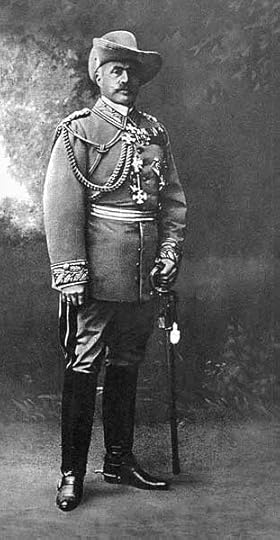
The Herero and Nama genocide or Namibian genocide, formerly known also as the Herero and Namaqua genocide, was a campaign of ethnic extermination and collective punishment which was waged against the Herero (Ovaherero) and the Nama in German South West Africa (now Namibia) by the German Empire. It was the first genocide to begin in the 20th century, occurring between 1904 and 1908. In January 1904, the Herero people, who were led by Samuel Maharero, and the Nama people, who were led by Captain Hendrik Witbooi, rebelled against German colonial rule. On 12 January 1904, they killed more than 100 German settlers in the area of Okahandja.
In August 1904, German General Lothar von Trotha defeated the Ovaherero in the Battle of Waterberg and drove them into the desert of Omaheke, where most of them died of dehydration. In October, the Nama people also rebelled against the Germans, only to suffer a similar fate. Between 24,000 and 100,000 Hereros and 10,000 Nama were killed in the genocide. The first phase of the genocide was characterized by widespread death from starvation and dehydration, due to the prevention of the Herero from leaving the Namib desert by German forces. Once defeated, thousands of Hereros and Namas were imprisoned in concentration camps, where the majority died of diseases, abuse, and exhaustion.
In 1985, the United Nations' Whitaker Report classified the aftermath as an attempt to exterminate the Herero and Nama peoples of South West Africa, and therefore one of the earliest attempts at genocide in the 20th century. In 2004, the German government recognised the events in what a German minister qualified as an "apology" but ruled out financial compensation for the victims' descendants.
In July 2015, the German government and the speaker of the Bundestag officially called the events a "genocide"; however, it refused to consider reparations at that time. Despite this, the last batch of skulls and other remains of slaughtered tribesmen which were taken to Germany to promote racial superiority were taken back to Namibia in 2018, with Petra Bosse-Huber [de], a German Protestant bishop, describing the event as "the first genocide of the 20th century".
In May 2021, the German government issued an official statement in which it said that Germany
"apologizes and bows before the descendants of the victims. Today, more than 100 years later, Germany asks for forgiveness for the sins of their forefathers. It is not possible to undo what has been done. But the suffering, inhumanity and pain inflicted on the tens of thousands of innocent men, women and children by Germany during the war in what is today Namibia must not be forgotten. It must serve as a warning against racism and genocide."
The same year, the German government agreed to pay €1.1 billion over 30 years to fund projects in communities that were impacted by the genocide.
The original inhabitants of what is now Namibia were the San and the Khoekhoe.
Herero, who speak a Bantu language, were originally a group of cattle herders who migrated into what is now Namibia during the mid-18th century. The Herero seized vast swathes of the arable upper plateaus which were ideal for cattle grazing. Agricultural duties, which were minimal, were assigned to enslaved Khoisan and Bushmen. Over the rest of the 18th century, the Herero slowly drove the Khoisan into the dry, rugged hills to the south and east.
The Hereros were a pastoral people whose entire way of life centred on their cattle. The Herero language, while limited in its vocabulary for most areas, contains more than a thousand words for the colours and markings of cattle. The Hereros were content to live in peace as long as their cattle were safe and well-pastured, but became formidable warriors when their cattle were threatened.
According to Robert Gaudi, "The newcomers, much taller and more fiercely warlike than the indigenous Khoisan people, were possessed of the fierceness that comes from basing one's way of life on a single source: everything they valued, all wealth and personal happiness, had to do with cattle. Regarding the care and protection of their herds, the Herero showed themselves utterly merciless, and far more 'savage' than the Khoisan had ever been. Because of their dominant ways and elegant bearing, the few Europeans who encountered Herero tribesmen in the early days regarded them as the region's 'natural aristocrats.'"
By the time of the Scramble for Africa, the area which was occupied by the Herero was known as Damaraland. The Nama were pastorals and traders and lived to the south of the Herero.
In 1883, Adolf Lüderitz, a German merchant, purchased a stretch of coast near Lüderitz Bay (Angra Pequena) from the reigning chief. The terms of the purchase were fraudulent, but the German government nonetheless established a protectorate over it. At that time, it was the only overseas German territory deemed suitable for European settlement.
Chief of the neighbouring Herero, Maharero rose to power by uniting all the Herero. 61 Faced with repeated attacks by the Khowesin, a clan of the Khoekhoe under Hendrik Witbooi, he signed a protection treaty on 21 October 1885 with Imperial Germany's colonial governor Heinrich Ernst Göring (father of Hermann Göring) but did not cede the land of the Herero. This treaty was renounced in 1888 due to lack of German support against Witbooi but it was reinstated in 1890.
The Herero leaders repeatedly complained about violation of this treaty, as Herero women and girls were raped by Germans, a crime that the German judges and prosecutors were reluctant to punish.
In 1890 Maharero's son, Samuel, signed a great deal of land over to the Germans in return for helping him to ascend to the Ovaherero throne, and to subsequently be established as paramount chief. 29 German involvement in ethnic fighting ended in tenuous peace in 1894. 48 In that year, Theodor Leutwein became governor of the territory, which underwent a period of rapid development, while the German government sent the Schutztruppe (imperial colonial troops) to pacify the region
German colonial policy
Both German colonial authorities and European settlers envisioned a predominantly white "new African Germany," wherein the native populations would be put onto reservations and their land distributed among settlers and companies. Under German colonial rule, colonists were encouraged to seize land and cattle from the native Herero and Nama peoples and to subjugate them as slave laborers.
Resentment brewed among the native populations over their loss of status and property to German ranchers arriving in South West Africa, and the dismantling of traditional political hierarchies. Previously ruling tribes were reduced to the same status as the other tribes they had previously ruled over and enslaved. This resentment contributed to the Herero Wars that began in 1904.
Major Theodor Leutwein, the Governor of German South West Africa, was well aware of the effect of the German colonial rule on Hereros. He later wrote: "The Hereros from early years were a freedom-loving people, courageous and proud beyond measure. On the one hand, there was the progressive extension of German rule over them, and on the other their own sufferings increasing from year to year
https://crosssides.blogspot.com/February 13, 2025
President Ronald Reagan was Racist
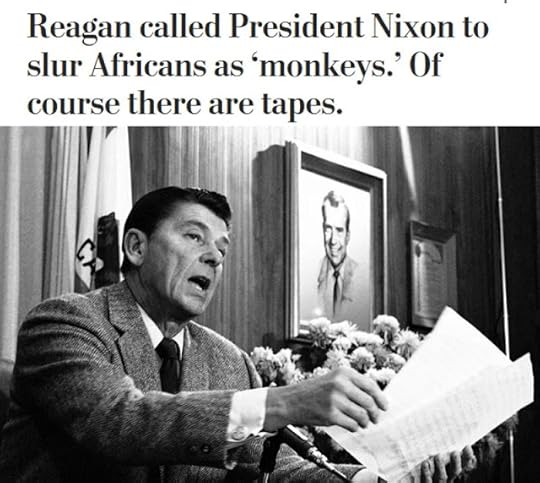
President Ronald Reagan was Racist.
The only thing shocking about the news that Reagan, the Republicans’ beloved secular god, made a racist comment is that there are people who are somehow surprised by this revelation. In the October 1971 audio clip, Reagan, then California’s governor, calls President Nixon to denounce a United Nations vote recognizing the People’s Republic of China, one celebrated by members of the Tanzanian delegation.
“Last night, I tell you, to watch that thing on television as I did . . . to see those, those monkeys from those African countries,” Reagan said. “Damn them, they’re still uncomfortable wearing shoes.”
Nixon, who taped the conversation, responded with a hearty laugh. (Always with the taping, that Tricky Dick.)
I hope I’m not breaking any news here when I say Nixon, too, was a racist.
“This October 1971 exchange between current and future presidents is a reminder that other presidents have subscribed to the racist belief that Africans or African Americans are somehow inferior,” Naftali, now a New York University history professor, wrote in an essay for The Atlantic. “The most novel aspect of President Donald Trump’s racist gibes isn’t that he said them, but that he said them in public.”
In a statement, the Ronald Reagan Presidential Foundation said, “If he said that 50 years ago, he shouldn’t have. And he would be the first person to apologize.”
There’s no “if.” That’s clearly Reagan’s voice. And Reagan’s list of apologies to black people would be far longer than contrition over a recorded slur. He bent one woman’s story, dubbing her a “welfare queen,” into a vile stereotype of black women hustling taxpayer dollars to support lavish lifestyles. Reagan then used it to attack housing benefits, aid to children in poverty, and food stamp programs. His disdain for the gay community made him ignore the ravages of AIDS, which also disproportionately affected straight black women and Haitians, for most of his presidency. Many were killed by presidential neglect, as well as the virus.
Racist beliefs lead to racist policies.
Yet this audio clip serves another purpose. It’s irrefutable evidence that racial animus was rooted within the GOP decades before Trump descended a Trump Tower escalator and slandered Mexican immigrants as “rapists” and “criminals.” It’s always been too easy for Republicans to pretend that Trump is a defect in their conservative machine. He’s not a bug; Trump is the inevitable result of its Southern Strategy, launched during Nixon’s 1968 presidential run.
Like failed presidential candidate Barry Goldwater in 1964, Nixon recognized that white fear and resentment of African-American progress and achievement is America’s eternal flame. That’s been the case since the end of the Civil War and the thwarted Reconstruction era.
Nixon exploited it. Reagan perfected it — with a smile.
That through-line of racism and racist calculation from Nixon to Trump didn’t skip Reagan. Always a better actor in political office than he was in Hollywood, Reagan honed his avuncular affability, and branded it “Morning in America.”
His 1980 election victory meant mourning in America for black people. In a 1960s essay called “Don’t Discount Reagan As the Next Threat to Negro,” baseball and civil rights icon Jackie Robinson predicted the hardships his community would face under a Reagan presidency.
“The backlashers,” as Robinson called those who opposed civil rights, “are anxious to see the central power of the U.S. go into the hands of a man who is clearly opposed to every step of social progress the nation has made in recent decades,” he wrote. Nominating Nixon or Reagan, Robinson said, “would be telling the black man it cares nothing about him or his concerns.”
Robinson died in 1973. He wouldn’t have been surprised by the toll that Reagan in the White House had on African-Americans less than a decade later.
Of course, the Reagan-as-racist storyline won’t stick for those who work hard to keep that artificial shine on his reputation. Never Trumpers get all twisted when the current president compares himself to the 40th; that’s because they believe Reagan is superior to Trump. It’s nothing more than salve for those horrified that the GOP’s longstanding racism is now indelibly writ large.
For the rest of us, the Reagan audio clip confirms what we already knew. There’s no deviation or detour between the man polluting the White House now and the one who, in 1980, ran on the slogan “Let’s Make America Great Again.”
!function(r,u,m,b,l,e){r._Rumble=b,r[b]||(r[b]=function(){(r[b]._=r[b]._||[]).push(arguments);if(r[b]._.length==1){l=u.createElement(m),e=u.getElementsByTagName(m)[0],l.async=1,l.src="https://rumble.com/embedJS/u2kzfpi&qu..., document, "script", "Rumble");Rumble("play", {"video":"v6id9s7","div":"rumble_v6id9s7"});https://crosssides.blogspot.com/
Racism in Watchtower Publications
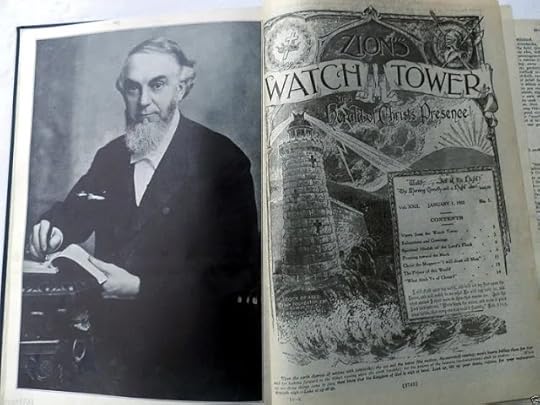
Black worshippers are now embraced as equals among Jehovah's Witnesses, but it hasn't always been this way.
Most Jehovah’s Witnesses believe the Watch Tower Society is completely beyond reproach when it comes to issues surrounding racism and racial equality. When attending a meeting, convention, or assembly of Jehovah’s Witnesses, one is instantly impressed at the intermingling and harmony between people of all ethnic backgrounds. Watchtower publications speak of all races being equal before a God who is “not partial.” Generally speaking, this philosophy filters down as a positive influence on the way members of different races treat one another within our organization. We even have a black brother, Samuel Herd, now sitting on the Governing Body!
However, things haven’t always been this way. In fact, the road to racial harmony has been just as “bumpy” for our organization as it has for many others. If you were to read some early Watchtower publications, you would doubtless be shocked and appalled by some of the offensive rhetoric employed by the writers of the Society’s literature back then. Indeed, if such literature was reprinted or otherwise circulated today as representing the Society’s current attitudes towards race, the organization would likely end up facing yet more serious legal entanglements, not to mention an outcry from their many non-white members spread across the globe.
Sadly, there are numerous examples of racial bigotry in the Society’s early literature, and few non-white races escape unscathed. I will attempt to catalogue some of the more offensive quotes in this article. For brevity, I will present a “timeline” of racist expressions as published by the Society, followed by a more thorough analysis of each quoted text in date order.
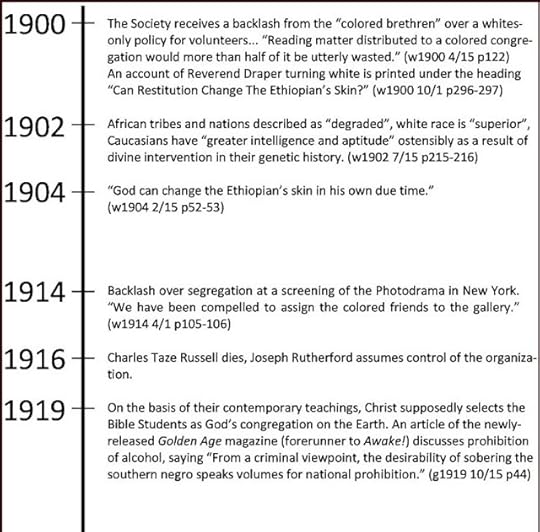
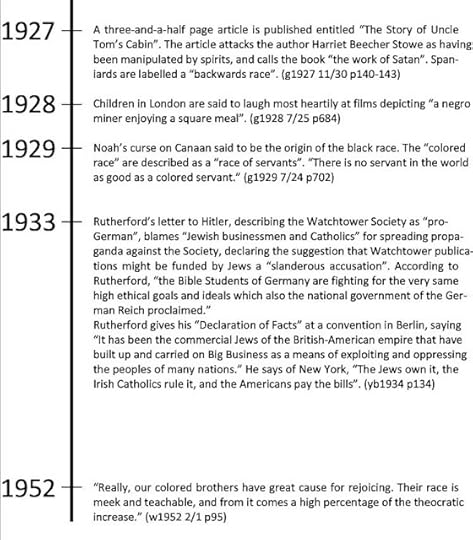
Quite understandably, some of the sentiments contained in the above timeline may horrify you, but they are all found in the Society’s publications or correspondence (as in the case of Rutherford’s letter to Hitler). It’s natural and commendable for you to respond in this way, since the Society’s own publications trained you to be tolerant of people of different races.
There is a reason the Society chooses to ignore their murky past when it comes to racial bigotry. It has to do with the prophetic significance they attach to the early “Bible Students,” as they were then known.
Put simply, the Watch Tower Society claims that Jesus Christ selected the Bible Students, led by Russell and Rutherford respectively, as representatives of his earthly organization in 1919. As you will see from the above timeline, this supposed “selection” by Christ came roughly right in the middle of a period when they were printing some of their most racially offensive articles. It seems inconceivable that Jesus Christ would recruit such a narrow-minded organization to represent him based on what they were writing at the time on matters of race. That is why the modern-day Society chooses to withhold this information, and instead points the finger at other religions for their racially bigoted histories.
Racism Under Russell
Charles Taze Russell was the founder of the Watch Tower Society, and the chief editor and publisher of Zion’s Watch Tower, as the Watchtower was known in those days.1 The distribution of the Watchtower magazine, as well as Russell’s other books, was almost entirely dependent on the work of “volunteers,” later known as colporteurs (the forerunners of today’s “pioneers”), whose job it was to offer subscriptions to readers. It seems that Russell was quite picky when it came to who could serve in this privileged capacity on behalf of the Society. In the March 1st issue of the Watchtower, his criteria deliberately restricted those who might serve as volunteers to members of “white Protestant churches.” Understandably, the black brothers at that time were none too pleased by the obvious discrimination, and wrote to the Society’s headquarters to complain. This was the printed response:
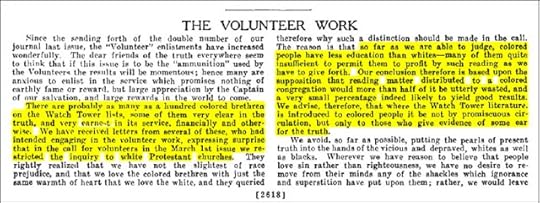
The above excerpt is taken from Zion’s Watch Tower, April 15th 1900, page 122.
Russell’s magazine freely acknowledged that its discriminatory advertisement for volunteers was founded on a stereotype of blacks having “less education than whites.” Then it expressed his outrageous opinion that “reading matter distributed to a colored congregation would more than half of it be utterly wasted.” It seems difficult to fathom how Russell, who blushed at suggestions that he was God’s “Faithful and Wise Servant,” could harbor and promulgate such a deplorable and misconceived attitude towards black men and women. This bizarre outlook presented itself in his other writings, most notably when he touched on his strange obsession with “the Ethiopian’s skin.”
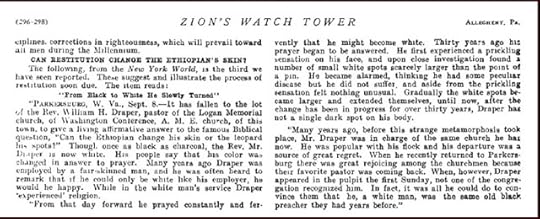
In the above article entitled “Can Restitution Change The Ethiopian’s Skin?” Russell leaps upon an incident whereby a black preacher claimed to have developed white skin after having prayed for it. Reverend Draper, who apparently told others that “if he could only be white like his employer, he would be happy,” started praying thirty years prior to the article and experienced a transformation over the period leading up to its publication. Once his skin was completely white, he returned to his former church, and had a hard time convincing the members of his identity. We now know that this “miraculous” transformation was the result of Vitiligo, a medical condition resulting in depigmentation of areas of skin. It isn’t that rare, and I’ve met people who have this condition. Perhaps you have too.
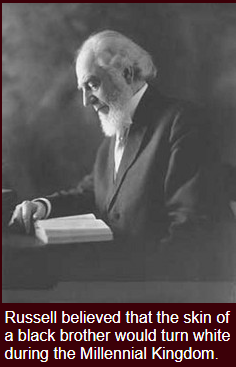
However, Russell was apparently so obsessed by the idea of black people becoming white that he would leap on any related report as evidence that this might happen on a grander scale in the future. The February 15, 1904 Watchtower reported a similar incident involving a nine-year-old boy named Julius Jackson under the heading “Can The Ethiopian Change His Skin?” which I reproduce below:
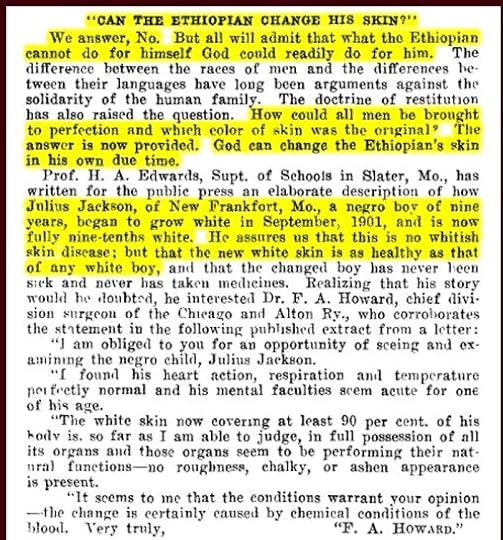
The above excerpt is taken from
Zion’s Watch Tower, February 15th 1904, pages 52-53.
Again, it’s difficult to fathom why Russell was so preoccupied with the concept of blacks becoming whites. What was so wrong for him about their original color? Why would the color of a person’s skin make any difference to a God who is “not partial”? I suppose only Russell knew that answer.
A telling insight into Russell’s attitudes towards race came in another Watchtower article in 1902. That article, entitled “The Negro Not A Beast,” attempted to banish the extremely offensive idea being promulgated in a book of the period that black men and women were somehow on a par with animals. Despite its tacit opposition to this outrageous concept, the Watchtower’s riposte was tainted by more than a hint of racist ideology.
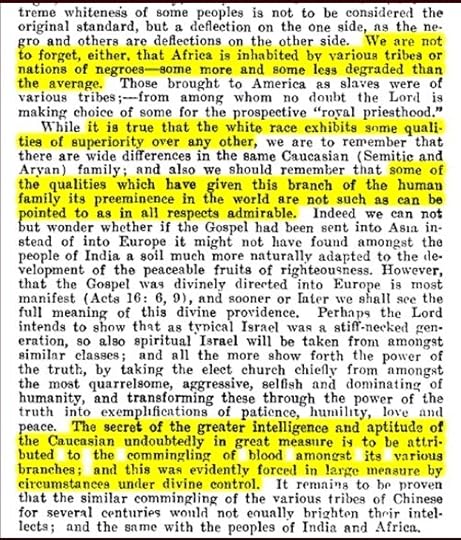
The above excerpt is taken from Zion’s Watch Tower, July 15th 1902, pages 215-216.
To paint Africa’s “various tribes or nations of negroes” as being “degraded” is a highly offensive racial slur by anyone’s standards. By comparison, it claims that the white race “exhibits some qualities of superiority over any other,” and enjoys “preeminence in the world.” Further down, that same article states that the Caucasian has “greater intelligence and aptitude” as a result of a “commingling of blood” under “divine control.” The article, which ironically sets out to counter racist arguments, ends up making more than a few of its own. We are left with an ideology that wouldn’t look out-of-place in a Nazi propaganda leaflet. Black people aren’t the only ones humiliated by this article; it also suggests that Indians and Chinese have some catching up to do genetically before they are to “equally brighten their intellects.”
At this point, it’s worth reminding ourselves that Charles Taze Russell didn’t necessarily pen these articles himself. Zion’s Watch Tower had at least five regular contributors. However, Russell was the chief editor and would have checked each article personally before approving it for print. Even if he hadn’t written a certain article himself, he would have signed off on it before publication in a magazine for which he was legally accountable. Therefore, readers may consider any racially offensive article published under his editorship as representing his views. I’m sure he would have scrapped any article without the slightest hesitation if it conflicted with his own opinions.
It wasn’t long before Russell’s dim view of the “colored brethren” generated yet more offense and outrage among his black readership. In January 1914, during a screening of the Photodrama of Creation at The Temple, West 63rd Street, a number of negro audience members were segregated from their white counterparts and made to sit separately on the balcony of the auditorium. This caused understandable outrage, and several wrote angry letters – furious that they had suffered such discrimination at the hands of their “brothers.” The Society printed a response under the heading “The Color Line Found Necessary” in the April 1 Watchtower, reproduced below:2
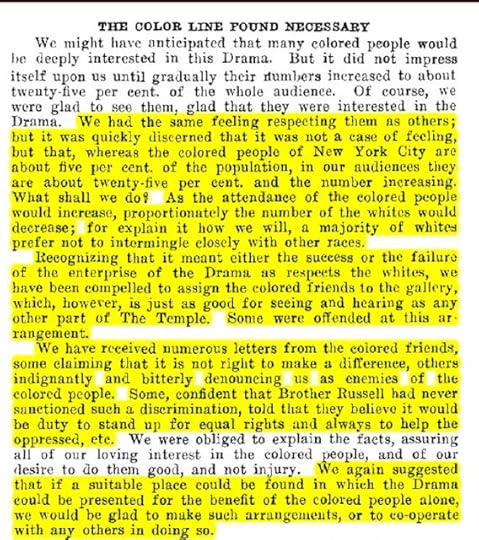
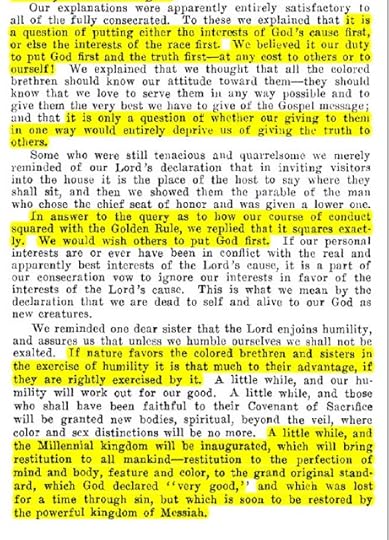
The above excerpt is taken from Zion’s Watch Tower, April 1st 1914, pages 105-106.
https://crosssides.blogspot.com/Mormons Evil in the Name of Religion
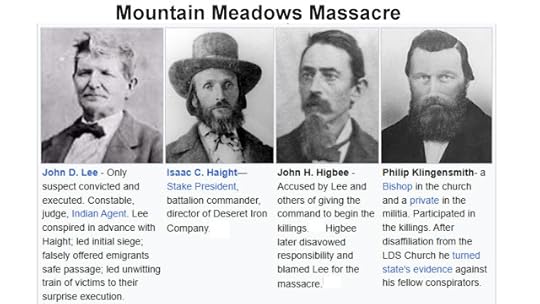
The Mountain Meadows Massacre (September 7–11, 1857) was a series of attacks during the Utah War that resulted in the mass murder of at least 120 members of the Baker–Fancher wagon train.
The massacre occurred in the southern Utah Territory at Mountain Meadows, and was perpetrated by settlers from the Church of Jesus Christ of Latter-day Saints (LDS Church) involved with the Utah Territorial Militia (officially called the Nauvoo Legion) who recruited and were aided by some Southern Paiute Native Americans.
The wagon train, made up mostly of immigrant families from Arkansas, was bound for California, traveling on the Old Spanish Trail that passed through the Territory.
After arriving in Salt Lake City, the Baker–Fancher party made their way south along the Mormon Road, eventually stopping to rest at Mountain Meadows. The party's journey occurred amidst hostilities between Mormon settlers and the U.S. government, with war hysteria rampant amongst the Mormons.
Acting on rumors of hostile behavior on the part of the travelers, local Mormon militia leaders, including Isaac C. Haight and John D. Lee, made plans to attack them as they camped at the meadow. The leaders of the militia, wanting to give the impression of tribal hostilities, persuaded Southern Paiutes to join with a larger party of militiamen disguised as Native Americans in an attack on the wagon train.
During the militia's first assault, the travelers fought back, and a five-day siege ensued. Eventually, fear spread among the militia's leaders that some immigrants had caught sight of the white men, likely discerning the actual identity of a majority of the attackers.
As a result, militia commander William H. Dame ordered his forces to kill the travelers. By this time, the travelers were running low on water and provisions, and allowed some members of the militia – who approached under a white flag – to enter their camp. The militia members assured the immigrants they were protected, and after handing over their weapons, the immigrants were escorted away from their defensive position.
After walking a distance from the camp, the militiamen, with the help of auxiliary forces hiding nearby, attacked the travelers. The perpetrators killed all the adults and older children in the group, in the end sparing only seventeen young children ages six and under.
Following the massacre, the perpetrators buried some of the remains but ultimately left most of the bodies exposed to wild animals and the climate. Local families took in the surviving children, with many of the victims' possessions and remaining livestock being auctioned off.
Investigations, which were interrupted by the American Civil War, resulted in nine indictments in 1874. Of the men who were indicted, only Lee was tried in a court of law. After two trials in the Utah Territory, Lee was convicted by a jury, sentenced to death and executed by firing squad on March 23, 1877.
Historians attribute the massacre to a combination of factors, including war hysteria about a possible invasion of Mormon territory and Mormon teachings against outsiders during the Mormon Reformation. Scholars debate whether senior leadership in the LDS Church, including Brigham Young, directly instigated the massacre or if responsibility for it lay only with the leaders of the militia.
Baker–Fancher party
In early 1857, the Baker–Fancher party was formed from several groups mainly from Marion, Crawford, Carroll and Johnson counties in northwestern Arkansas. They assembled into a wagon train at Beller's Stand, south of Harrison, to emigrate to southern California. The group was initially referred to as both the Baker train and the Perkins train, but later referred to as the Baker–Fancher train (or party).
It was named after "Colonel" Alexander Fancher who, having already made the journey to California twice before, had become its main leader. By contemporary standards the Baker–Fancher party was prosperous, carefully organized and well-equipped for the journey. They were joined along the way by families and individuals from other states, including Missouri. The group was relatively wealthy, and planned to restock its supplies in Salt Lake City, as did most wagon trains at the time.
Interactions with Mormon settlers
At the time of the Fanchers' arrival, the Utah Territory, though legally a democracy, was effectively a theocracy under the leadership of Brigham Young, the second president of the Church of Jesus Christ of Latter-day Saints (LDS Church), who had established colonies along the California Trail and the Old Spanish Trail. U.S. President James Buchanan had recently issued an order to send federal troops to Utah, which led to rumors being spread in the territory about its motives. Young issued various orders that urged the local population to prepare for the arrival of the troops. Eventually Young issued a declaration of martial law.
The Baker–Fancher party was refused provisions in Salt Lake City and chose to leave there and take the Old Spanish Trail, which passed through southern Utah. In August 1857, the Mormon apostle George A. Smith traveled throughout the southern part of the territory instructing Mormon settlers to stockpile grain.
While on his return trip to Salt Lake City, Smith camped near the Baker–Fancher party on August 25, 1857, at Corn Creek. They had traveled the 165 miles (266 km) south from Salt Lake City, and Jacob Hamblin suggested that the wagon train continue on the trail and rest their cattle at Mountain Meadows, which had good pasture and was adjacent to his homestead.
While most witnesses said that the Fanchers were in general a peaceful party whose members behaved well along the trail, rumors spread about their supposed misdeeds. United States Army Brevet Major James Henry Carleton led the first federal investigation of the murders, and the findings were published in 1859. He recorded Hamblin's account that the train was alleged to have poisoned a spring near Corn Creek, resulting in the deaths of eighteen cows and two or three people who ate the contaminated meat.
Carleton interviewed the father of a child who allegedly died from this poisoned spring and accepted the sincerity of the grieving father. He also included a statement from an investigator who did not believe the Fancher party was capable of poisoning the spring, given its size. Carleton invited readers to consider a potential explanation for the rumors of misdeeds, noting the general atmosphere of distrust among Mormons for strangers at the time, and that some locals appeared jealous of the Fancher party's wealth.
Killings and aftermath
On Friday, September 11, 1857, two militiamen approached the Baker–Fancher party wagons with a white flag and were soon followed by Indian Agent and militia officer John D. Lee. Lee told the battle-weary emigrants that he had negotiated a truce with the Paiutes. Under Mormon protection, the wagon-train members would be escorted safely back to Cedar City, 36 miles (58 km) away, in exchange for turning all of their livestock and supplies over to the Native Americans.
Accepting this offer, the emigrants were led out of their fortification, with the adult men being separated from the women and children. The men were paired with a militia escort and when the signal was given, the militiamen turned and shot the male members of the Baker–Fancher party standing by their side.
The women and children were then ambushed and killed by more militia that were hiding in nearby bushes and ravines. Members of the militia were sworn to secrecy. A plan was set to blame the massacre on the Native Americans.
Survivor Nancy Saphrona Huff was taken away along with her family's possessions by John Willis to reside at his house until she was returned to relatives in Arkansas two years later.
The militia did not kill small children who were deemed too young to relate what had happened. Nancy Huff, one of the seventeen survivors and just over four years old at the time of the massacre, recalled in an 1875 statement that an eighteenth survivor was killed directly in front of the other children. "At the close of the massacre there was eighteen children still alive, one girl, some ten or twelve years old, they said was too big and could tell, so they killed her, leaving seventeen."
The survivors were taken in by local Mormon families. Seventeen of the children were later reclaimed by the U.S. Army and returned to relatives in Arkansas.
The treatment of these children while they were held by the Mormons is uncertain, but Captain James Lynch's statement in May 1859 said the surviving children were "in a most wretched condition, half starved, half naked, filthy, infested with vermin, and their eyes diseased from the cruel neglect to which they had been exposed." Lynch's July 1859 affidavit added that they when they first saw the children they had "little or no clothing" and were "covered with filth and dirt".
Survivor Christopher "Kit" Fancher as an adult.
Leonard J. Arrington, founder of the Mormon History Association, reports that Brigham Young received the rider, James Haslam, at his office on the same day. When he learned what was contemplated by the militia leaders in Parowan and Cedar City, he sent back a letter stating the Baker–Fancher party was not to be meddled with, and should be allowed to go in peace (although he acknowledged the Native Americans would likely "do as they pleased"). Young's letter arrived two days too late, on September 13, 1857.
The livestock and personal property of the Baker–Fancher party, including women's jewelry, clothing and bedstuffs were distributed or auctioned off to Mormons. Some of the surviving children saw clothing and jewelry that had belonged to their dead mothers and sisters subsequently being worn by Mormon women and the journalist J.H. Beadle said that jewelry taken from Mountain Meadows was seen in Salt Lake City.
Investigations and prosecutions
An early investigation was conducted by Brigham Young, who interviewed John D. Lee on September 29, 1857. In 1858, Young sent a report to the Commissioner of Indian Affairs stating that the massacre was the work of Native Americans. The Utah War delayed any investigation by the U.S. federal government until 1859, when Jacob Forney and U.S. Army Brevet Major James Henry Carleton conducted investigations.
In Carleton's investigation, at Mountain Meadows he found women's hair tangled in sage brush and the bones of children still in their mothers' arms. Carleton later said it was "a sight which can never be forgotten." After gathering up the skulls and bones of those who had died, Carleton's troops buried them and erected a cairn and cross.
Carleton interviewed a few local Mormon settlers and Paiute Native American chiefs and concluded that there was Mormon involvement in the massacre. He issued a report in May 1859, addressed to the U.S. Assistant Adjutant-General, setting forth his findings. Jacob Forney, Superintendent of Indian Affairs for Utah, also conducted an investigation that included visiting the region in the summer of 1859.
Forney retrieved many of the surviving children of massacre victims who had been housed with Mormon families and gathered them up for transportation to their relatives in Arkansas. Forney concluded that the Paiutes did not act alone and the massacre would not have occurred without the white settlers, and Carleton report to the U.S. Congress called the mass killings a "heinous crime", blaming both local and senior church leaders for the massacre.
In March 1859, Judge John Cradlebaugh, a federal judge brought into the territory after the Utah War, convened a grand jury in Provo concerning the massacre, but the jury declined any indictments. Nevertheless, Cradlebaugh conducted a tour of the Mountain Meadows area with a military escort. He attempted to arrest John D. Lee, Isaac Haight, and John Higbee, who fled before they could be found.
Cradlebaugh publicly charged Brigham Young as an instigator to the massacre and therefore an "accessory before the fact". Possibly as a protective measure against the mistrusted federal court system, Mormon territorial probate court judge Elias Smith arrested Young under a territorial warrant, perhaps hoping to divert any trial of Young into a friendly Mormon territorial court. Apparently because no federal charges ensued, Young was released.
Further investigations were cut short by the American Civil War in 1861, but proceeded in 1871 when prosecutors obtained the affidavit of militia member Philip Klingensmith. Klingensmith had been a bishop and blacksmith from Cedar City; by the 1870s, however, he had left the church and moved to Nevada.
Lee was arrested on November 7, 1874. Dame, Philip Klingensmith, Ellott Willden, and George Adair Jr. were indicted and arrested while warrants to pursue the arrests of four others who had gone into hiding (Haight, Higbee, William C. Stewart, and Samuel Jukes) were being obtained. Klingensmith escaped prosecution by agreeing to testify. Brigham Young excommunicated some participants, including Haight and Lee, from the LDS Church in 1870. The U.S. posted bounties of $5000 USD (equivalent to $120,500 in 2023) each for the capture of Haight, Higbee, Stewart, and Klingensmith.
Lee's first trial began on July 23, 1875, in Beaver, before a jury of eight Mormons and four non-Mormons. One of Lee's defense attorneys was Enos D. Hoge, a former territorial supreme court justice. The trial led to a hung jury on August 5, 1875. Lee's second trial began September 13, 1876, before an all-Mormon jury. The prosecution called Daniel Wells, Laban Morrill, Joel White, Samuel Knight, Samuel McMurdy, Nephi Johnson, and Jacob Hamblin.
Lee also stipulated, against advice of counsel, that the prosecution be allowed to re-use the depositions of Young and Smith from the previous trial. Lee called no witnesses in his defense, and was convicted.
Lee was entitled under Utah Territorial statute to choose the method of his execution from three possible options: hanging, firing squad, or decapitation. At sentencing, Lee chose to be executed by firing squad. In his final words before his sentence was carried out at Mountain Meadows on March 23, 1877, Lee said that he was a scapegoat for others involved. Brigham Young stated that Lee's fate was just, but it was not a sufficient blood atonement, given the enormity of the crime.
Further investigations were cut short by the American Civil War in 1861, but proceeded in 1871 when prosecutors obtained the affidavit of militia member Philip Klingensmith. Klingensmith had been a bishop and blacksmith from Cedar City; by the 1870s, however, he had left the church and moved to Nevada.
Lee was arrested on November 7, 1874. Dame, Philip Klingensmith, Ellott Willden, and George Adair Jr. were indicted and arrested while warrants to pursue the arrests of four others who had gone into hiding (Haight, Higbee, William C. Stewart, and Samuel Jukes) were being obtained. Klingensmith escaped prosecution by agreeing to testify. Brigham Young excommunicated some participants, including Haight and Lee, from the LDS Church in 1870. The U.S. posted bounties of $5000 USD (equivalent to $120,500 in 2023) each for the capture of Haight, Higbee, Stewart, and Klingensmith.
Lee's first trial began on July 23, 1875, in Beaver, before a jury of eight Mormons and four non-Mormons. One of Lee's defense attorneys was Enos D. Hoge, a former territorial supreme court justice. The trial led to a hung jury on August 5, 1875. Lee's second trial began September 13, 1876, before an all-Mormon jury. The prosecution called Daniel Wells, Laban Morrill, Joel White, Samuel Knight, Samuel McMurdy, Nephi Johnson, and Jacob Hamblin.
Lee also stipulated, against advice of counsel, that the prosecution be allowed to re-use the depositions of Young and Smith from the previous trial. Lee called no witnesses in his defense, and was convicted.
Lee was entitled under Utah Territorial statute to choose the method of his execution from three possible options: hanging, firing squad, or decapitation. At sentencing, Lee chose to be executed by firing squad. In his final words before his sentence was carried out at Mountain Meadows on March 23, 1877, Lee said that he was a scapegoat for others involved. Brigham Young stated that Lee's fate was just, but it was not a sufficient blood atonement, given the enormity of the crime.
https://crosssides.blogspot.com/February 12, 2025
The Finality of Babylon’s Doom
Revelation 18

Lament Over Fallen Babylon
After this I saw another angel coming down from heaven. He had great authority, and the earth was illuminated by his splendor. With a mighty voice he shouted: “‘Fallen! Fallen is Babylon the Great!’ She has become a dwelling for demons and a haunt for every impure spirit, a haunt for every unclean bird, a haunt for every unclean and detestable animal. For all the nations have drunk the maddening wine of her adulteries. The kings of the earth committed adultery with her, and the merchants of the earth grew rich from her excessive luxuries.”
Warning to Escape Babylon’s Judgment
Then I heard another voice from heaven say: ‘Come out of her, my people,’ so that you will not share in her sins, so that you will not receive any of her plagues; for her sins are piled up to heaven, and God has remembered her crimes. Give back to her as she has given; pay her back double for what she has done. Pour her a double portion from her own cup. Give her as much torment and grief as the glory and luxury she gave herself. In her heart she boasts, ‘I sit enthroned as queen. I am not a widow; I will never mourn.’ Therefore in one day her plagues will overtake her: death, mourning and famine. She will be consumed by fire, for mighty is the Lord God who judges her.
Threefold Woe Over Babylon’s Fall
“When the kings of the earth who committed adultery with her and shared her luxury see the smoke of her burning, they will weep and mourn over her. Terrified at her torment, they will stand far off and cry: “‘Woe! Woe to you, great city, you mighty city of Babylon! In one hour your doom has come!’ “The merchants of the earth will weep and mourn over her because no one buys their cargoes anymore— cargoes of gold, silver, precious stones and pearls; fine linen, purple, silk and scarlet cloth; every sort of citron wood, and articles of every kind made of ivory, costly wood, bronze, iron and marble; cargoes of cinnamon and spice, of incense, myrrh and frankincense, of wine and olive oil, of fine flour and wheat; cattle and sheep; horses and carriages; and human beings sold as slaves.
“They will say, ‘The fruit you longed for is gone from you. All your luxury and splendor have vanished, never to be recovered.’ 15 The merchants who sold these things and gained their wealth from her will stand far off, terrified at her torment. They will weep and mourn and cry out: ‘Woe! Woe to you, great city, dressed in fine linen, purple and scarlet, and glittering with gold, precious stones and pearls! In one hour such great wealth has been brought to ruin!’
“Every sea captain, and all who travel by ship, the sailors, and all who earn their living from the sea, will stand far off. When they see the smoke of her burning, they will exclaim, ‘Was there ever a city like this great city?’ They will throw dust on their heads, and with weeping and mourning cry out: ‘Woe! Woe to you, great city, where all who had ships on the sea became rich through her wealth! In one hour she has been brought to ruin!’ “Rejoice over her, you heavens! Rejoice, you people of God! Rejoice, apostles and prophets! For God has judged her with the judgment she imposed on you.”
The Finality of Babylon’s Doom
Then a mighty angel picked up a boulder the size of a large millstone and threw it into the sea, and said: “With such violence the great city of Babylon will be thrown down, never to be found again. The music of harpists and musicians, pipers and trumpeters, will never be heard in you again. No worker of any trade will ever be found in you again. The sound of a millstone will never be heard in you again. The light of a lamp will never shine in you again. The voice of bridegroom and bride will never be heard in you again. Your merchants were the world’s important people. By your magic spell all the nations were led astray. In her was found the blood of prophets and of God’s holy people, of all who have been slaughtered on the earth.”
https://crosssides.blogspot.com/February 11, 2025
Pawns of America
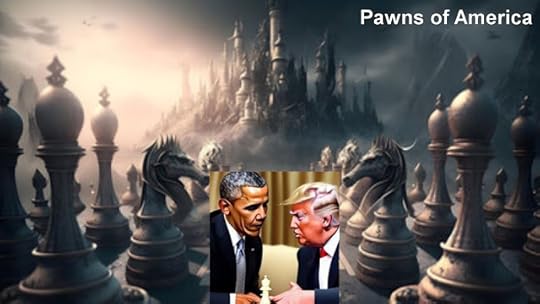
Take your stand against the devil’s schemes by being strong in the Lord God and live by the spirit. Trey Knowles’s allegory comedy “Pawns of America” shows us that our struggle is not against flesh and blood, but against the rulers, principalities against the authorities, against the powers of this dark world, and the spiritual forces of evil in the heavenly realms.
Pawns of America shows you how the principalities of this world can orchestrate people's behavior by using manipulation and gaslighting tactics. This is how it is done. The Principalities will target the desires of the heart, to manipulate the stereotypic ideology of the individuals.
Stereotyping behavior of ideology refers to the tendency for people holding a particular political or social ideology to overgeneralize characteristics about individuals belonging to opposing ideologies, often relying on simplistic and preconceived notions about those groups, which can lead to prejudice and discrimination based on their perceived political affiliation rather than individual traits.
Powerful people and organization can cause people to kill each other by manipulating them based on individual behavior of ideology. For example, hate groups.
Since Mankind has been and is divided into three parts: the Haves, the Have-Nots, and the Have-a-Little, Want More, so when there is greed and coveting people can easily be controlled and manipulated based on their wants and desires using behavioral sorcery. Political behavioral sorcery is a weapon to turn citizens of America into schizophrenic behavior.
Now the political sorcery game is played in America like this. Between the Haves and Have-Nots are the Have-a-Little, Want More--the middle class. The people in America are torn between upholding the status quo to protect the little they have, and wanting change to get more, they become split personalities. They could be described as social, economic, and political schizoids. Generally, they seek a safe way, where they can profit by change and yet not risk losing the little, they have. They insist on a minimum of three aces before playing a hand in the poker game of revolution.
Thermo Politically they are tepid and rooted in inertia. Today in Western society and particularly in the United States they comprise the majority of our population.”
In Trey Knowles’s Pawns of America, Trey Knowles exposes the chess match that is taking place between the principalities of this world, one for the Haves which equals “Trump” and for Have Nots which equals “Obama”. Both of these principalities are trying to orchestrate people's behavior for control and the glory of their own sovereignty.
For where our treasure is, there our heart will be also. So, if our heart is with the Lord, then he is our main source and we cannot be manipulated by any principalities in this world because our treasure is in the Lord and there is our heart.
We are more than conquerors, and we will counter attack the principalities of this world.
It is written in Ephesians 6:13-17 says therefore put on the full armor of God, so that when the day of evil comes, you may be able to stand your ground, and after you have done everything, to stand. Stand firm then, with the belt of truth buckled around your waist, with the breastplate of righteousness in place, and with your feet fitted with the readiness that comes from the gospel of peace. In addition to all this, take up the shield of faith, with which you can extinguish all the flaming arrows of the evil one. Take the helmet of salvation and the sword of the Spirit, which is the word of God.
We will not be pawns of the principalities of this world.
February 10, 2025
Clean Up America
Trey Knowles's Clean Up America is a message for America to change and reform to the images of God and not to the flesh.
Galatians 5:16-21 says.
So I say, walk by the Spirit, and you will not gratify the desires of the flesh. For the flesh desires what is contrary to the Spirit, and the Spirit what is contrary to the flesh. They are in conflict with each other, so that you are not to do whatever you want. But if you are led by the Spirit, you are not under the law.
The acts of the flesh are obvious: sexual immorality, impurity and debauchery; idolatry and witchcraft; hatred, discord, jealousy, fits of rage, selfish ambition, dissensions, factions and envy; drunkenness, orgies, and the like. I warn you, as I did before, that those who live like this will not inherit the kingdom of God.

February 9, 2025
Repent or Perish

Do not be wise in your own eyes; fear the Lord and shun evil. Proverbs 3:7
Note: Shun means to turn away from evil:
Repent, then, and turn to God, so that your sins may be wiped out, that times of refreshing may come from the Lord. Acts 3:19
They must turn from evil and do good; they must seek peace and pursue it. 1 Peter 3:11
Note: Seek peace: Live the way God intends for you to live
Repent or PerishLuke 13: Now there were some present at that time who told Jesus about the Galileans whose blood Pilate had mixed with their sacrifices. Jesus answered, “Do you think that these Galileans were worse sinners than all the other Galileans because they suffered this way? I tell you, no! But unless you repent, you too will all perish. Or those eighteen who died when the tower in Siloam fell on them—do you think they were more guilty than all the others living in Jerusalem? I tell you, no! But unless you repent, you too will all perish.”
Then he told this parable: “A man had a fig tree growing in his vineyard, and he went to look for fruit on it but did not find any. So he said to the man who took care of the vineyard, ‘For three years now I’ve been coming to look for fruit on this fig tree and haven’t found any. Cut it down! Why should it use up the soil?’
“‘Sir,’ the man replied, ‘leave it alone for one more year, and I’ll dig around it and fertilize it. If it bears fruit next year, fine! If not, then cut it down.’”
https://crosssides.blogspot.com/February 8, 2025
Comedy: Message From North Sentinel Island
Message From North Sentinel Island is an allegory comedy where Indigenous people show black Americans how to say no to ungodliness and not take the devil's bread or lifestyle.
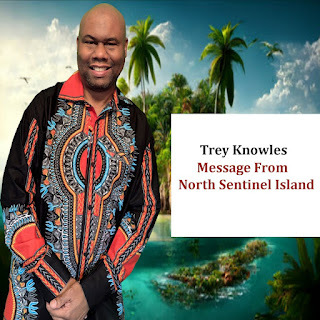
February 7, 2025
North Sentinel Island
North Sentinel Island is one of the Andaman Islands, an Indian archipelago in the Bay of Bengal which also includes South Sentinel Island. The island is a protected area of India. It is home to the Sentinelese, an indigenous tribe in voluntary isolation who have defended, often by force, their protected isolation from the outside world.
+1⁄2 miles) wide, and its area is approximately 60 square kilometres (23 sq mi).
The Andaman and Nicobar Islands Protection of Aboriginal Tribes Regulation 1956 prohibits travel to the island and any approach closer than five nautical miles (nine kilometres), in order to protect the remaining tribal community from "mainland" infectious diseases against which they likely have no acquired immunity. The area is patrolled by the Indian Navy.
Nominally, the island belongs to the South Andaman administrative district, part of the Indian union territory of Andaman and Nicobar Islands. In practice, Indian authorities recognise the islanders' desire to be left alone, restricting outsiders to remote monitoring (by boat and sometimes air) from a reasonably safe distance; the Government of India will not prosecute the Sentinelese for killing people in the event that an outsider ventures ashore. In 2018, the Government of India excluded 29 islands—including North Sentinel—from the Restricted Area Permit (RAP) regime, in a major effort to boost tourism.
In November 2018, the government's home ministry stated that the relaxation of the prohibition on visitations was intended to allow researchers and anthropologists (with pre-approved clearance) to finally visit the Sentinel islands.
The Sentinelese have repeatedly attacked approaching vessels, whether the boats were intentionally visiting the island or simply ran aground on the surrounding coral reef. The islanders have been observed shooting arrows at boats, as well as at low-flying helicopters. Such attacks have resulted in injury and death. In 2006, islanders killed two fishermen whose boat had drifted ashore, and in 2018 an American Christian missionary, 26-year-old John Chau, was killed after he illegally attempted to make contact with the islanders three separate times and paid local fishermen to transport him to the island.
Have you ever heard of the North Sentinel Island, a remote island in the Bay of Bengal, India? This mysterious and isolated island has been out- limits to outsiders for decades. With the help of drone technology, we’re now suitable to explore this enigmatic island and gain a better understanding of its inhabitants and their way of life.
IntroductionThe North Sentinel Island is one of the last remaining tribes that remain uncontacted by ultramodern civilization. The Sentinelese people, who inhabit the island, are known for their hostility towards outsiders and have been known to attack anyone who tries to approach their land. Due to their resistance, little is known about the tribe and their way of life. still, recent advancements by drone technology have allowed us to get a glimpse into this uncommunicative community.
The Drone North Sentinel IslandUsing drone technology, we’re now suitable to study the North Sentinel Island from a safe distance. The drones allow us to capture upstanding footage of the island and its inhabitants without disturbing their way of life. This technology has been critical in uncovering the mysteries of this isolated island.
The Geography of the North Sentinel IslandThe North Sentinel Island is a small island located in the Bay of Bengal, measuring roughly 72 square kilometers. The island is girdled by coral reefs, which make it delicate to approach by boat. The thick jungle and thick vegetation on the island make it nearly insolvable to explore on foot.
The Sentinelese PeopleThe Sentinelese people are believed to have inhabited the North Sentinel Island for thousands of years. The tribe is estimated to have a population of roughly 50- 150 individuals, making it one of the lowest and most isolated tribes in the world.
The Sentinelese CultureThe culture of the Sentinelese people is shrouded in mystery. Due to their hostility towards outsiders, little is known about their way of life. still, from the limited observations made by anthropologists and through the use of drones, we’ve been suitable to gain some insight into their culture.
The Sentinelese LanguageThe language of the Sentinelese people is unique and has not been completely understood by linguists. It’s believed to be a language isolate, meaning that it isn’t related to any other language in the world.




